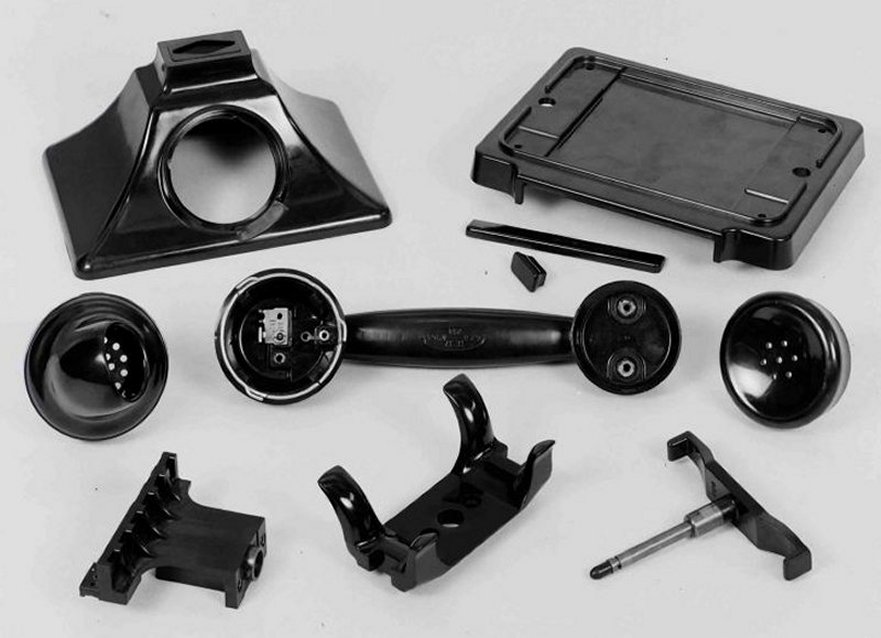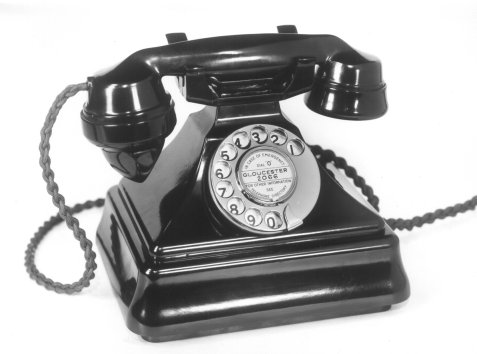TELEPHONE No. 232 & 1/232 |
|||||||||||||||||||||||||||||||
|
Bakelite table telephone used on Automatic and C.B. exchanges in conjunction with a Bellset No. 26. This telephone is fitted with a handset called a Telephone No. 164. There is no bell or capacitor fitted inside the telephone, so a Bellset No. 26 would have normally been fitted. The C.B. version is fitted with a Bakelite blank plate in place of the dial and a metal link is fitted inside the telephone, where the dial pulse springs would be connected. This telephone Telephone No. 232 was introduced in 1935 and superseded the Telephone No. 162. The Telephone No. 162 contained a transformer, which is not an induction coil, and the induction coil was fitted in the adjacent Bellset. The Telephone No. 232 was fitted with one of the later ASTIC induction coils, which gave superior transmission and because of this the transformer was not required, so the induction coil was fitted inside the telephone case. The Telephone No. 1/232 was released in 1937 and this superseded the Telephone No. 1/162. The main difference between a Telephone No. 232 and a Telephone No. 1/232 (see picture above) is that the former has only a flat base plate, whereas the later has a drawer in the base plate. This telephone was available in the colours: Black, Ivory, Chinese Red and Jade Green. Others colours were available (Silver and Gold) for a period of time and for a payment the telephone could be painted to the colour of the subscribers choice. Optional items for this telephone were a lamp fitting and a second receiver. They were both mounted on a bracket that was clamped around the neck of the telephone, just above the dial. The Lamp Fitting No. 14B came complete with lamp and bracket, whilst the extra receiver used a Receiver, Watch No. 7P and a Hook, Receiver 'L'. The Mk 1 (1935) and Mk 2 (1948) designs of the Telephone No. 232 made different use of terminals 6 and 8, as the two phones were not wired the same. Terminals 6 and 8 were reversed which meant that the green wire of the handset cord could be on one of two terminals. The green handset wire on the Mark 1 used terminal 6 whilst the Mark 2 used terminal 8. The case may have the wrong paster diagram in it so the wiring should be checked if restoration is taking place. Both diagrams can be found here The Telephone No. 232 Mark 1 is fitted with a Coil, Induction No. 20, whilst the Telephone No. 1/232 Mark 1 is fitted with a Coil, Induction No. 24. The circuit is identical. The Telephone No. 232 Mark 2 and 1/232 Mark 2 is fitted with a Coil, Induction No. 27. Terminal nuts are 4BA (Part No. 1/SNU/51). The frame that supports the switch hooks, also has terminals
and contact springs attached. The contact springs came
with either one contact or two contacts per spring. This
telephone could use either - the parts numbers are as follows:- In 1961 braided handset cords were superseded by an extensible, coiled, cord called the Cords, Instrument No. 3/110AK, Black, 10". These can be found on factory refurbished telephones, or telephones repaired on customers premises. Whilst the telephone was essentially a table model, a Bracket No. 14 was made available for wall mounting the telephone. See pictures below.
Telephone No. 232 on a bracket No. 14
Bracket No. 14
Telephone No. 1/232 (Mark 2) includes (Rate Book 1946 and 1956):-
Circuit diagram - N332 (Mark 1) & (Mark 2). Paster Diagram - Mark 1 - Mark 2 (Size 90mm x 90mm). Circuit Diagram for connecting a Telephone No. 232 to a Bellset No. 26 - N4300. Specification - S93. General information on 200 type telephones Collectors Information - what to look for How to dismantle a 200 type telephone How to wire your Telephone No. 232 to make it work on the UK BT Plug and Sockets How to wire your phone to work on the German telephone system Labels that fit in the sliding tray How to fit a Bellset to a Pyramid Telephone Click here for pictures of the 200 type Telephone - from all angles General fault finding on your phone Additional good quality pictures
Telephone No. 232CB Black
Telephone No. 232CB Ivory
Telephone No. 232F in silver
Telephone No. 232 mounted on a Bellset No. 26
Later base with drawer
Close up showing the internal connections
Telephone No. 232, 1/232 or 2/232? Telephone No. 232, a development of the Telephone No. 162, was introduced in 1935. It featured improved electrical performance derived from an improved ASTIC circuit and large numbers remained in use into the late 1950s and a few until around 1970, making it a very successful and long-lived design. This telephone had no bell installed within the body, so if a bell was required then an associated Bellset would have to fitted on the wall. The Bellset could be fixed under the telephone with special screws - some people describe these telephones as a "King Pyramid". Click here for more information. Later versions featured a drawer in the base (for dialling instructions or number lists) and an improved cradle fork design made of cellulose acetate instead of Bakelite that was less damage-prone and made the telephone easier to carry around. These were numbered No. 1/232 or No. 2/232. Simon Chappell explains this concisely: I think most people might define the two types as ‘162 cradles’ and ‘232 cradles’. The earlier type closely follows the profile of the top of the ‘pyramid’ whereas the later type overhangs to provide the lip. The general consensus on the cradles is:-
Not all these telephones have the pull-out drawer and of those that do (types 1/232 and 2/232 made with coloured cases) generally have a stainless steel cover and a clip for a notepad, in the pull out drawer. Some stainless steel covers had the GPO roundel, embossed in red, stamped in the middle. Manufactured by: All main UK telephone suppliers. Bakelite parts were also made (in black only) in Christchurch, New Zealand, by a local manufacturer called H. C. Urlwin (Harry Urlwin) where the mouldings carried the maker’s mark H C U N Z . Colours: Black, ivory, red and green. The ivory models are hard to find in perfect condition as the moulding material (which is not Bakelite but Urea Formaldehyde) often deteriorates badly. Either the manufacturers had difficulty mixing the ingredients or else the material was unstable from the outset. It often cracks and goes like toffee ripple ice cream, with swirls of yellow-brown in the ivory. Users: GPO and other telephone and railway administrations in Britain and the British Commonwealth. An example made by Siemens Brothers has been noted with Arabic numerals on the dial and ESR (standing for Egyptian State Railways) in the oval recess of the handset. Variants: 232 Standard table telephone, for use in CB/auto areas with Bellset No.26, with no drawer. 1/232 Development of the Telephone No. 232, with induction coil Nos. 22 or 24, lipped cradle and drawer in base. 2/232 Improved circuit, with induction coil No. 27 and drawer in base. The
Mark
1 and Mark 2 designs of the Telephone No. 232 made different use of
terminals 6 and 8. Restorers should note this
carefully; as telephone collector bought a phone with a Mark
1 case
(and paster diagram) but with Mark 2 innards. It did not work
because
the handset cord had been connected according to the paster
diagram!
Both diagrams can be found
here Other types based on this model:- Tele.
238 Tele.
240 Tele.
242 Tele.
244 Tele.
246 Tele.
248 Tele.
264
Pictures |
|||||||||||||||||||||||||||||||
Last revised: December 18, 2023FM |















